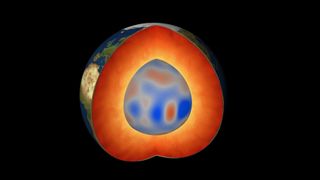New type of magnetic wave might explain the strange fluctuations in Earth's magnetic field
The waves propagate deep within the planet.

A new type of slowly traveling magnetic wave discovered inside Earth may shed light on some unexplained fluctuations in the planet's magnetic field.
Earth's magnetic field, generated by its core of molten metals, protects the planet from harmful cosmic radiation. Despite decades of research, scientists still don't fully understand the field's behavior. Over the past 20 years, they have seen strange fluctuations in satellite measurements of the field's strength, which they couldn't explain.
Now, a new study, based on data from the European Space Agency's (ESA) Swarm mission, has revealed a previously unknown type of magnetic wave that might be behind the odd behavior.
The wave propagates more than 1,860 miles (3,000 kilometers) below Earth's surface, where the planet's core meets its mantle. It travels westward at 930 miles (1,500 km) per year, which means it circumnavigates the globe every seven years.
Related: Earth's last magnetic-pole flip took much longer than we thought
"Geophysicists have long theorized over the existence of such waves, but they were thought to take place over much longer time scales than our research has shown," Nicolas Gillet, a geophysicist at the University of Grenoble Alpes in France and the lead author of the new paper, said in an ESA statement. "Measurements of the magnetic field from instruments based on the surface of Earth suggested that there was some kind of wave action, but we needed the global coverage offered by measurements from space to reveal what is actually going on."
The researchers combined data from the three satellites of the Swarm constellation with measurements from the now retired German satellite CHAMP and the Danish Ørsted. When the team ran the measured oscillations through a computer model simulating Earth's geodynamo, the process of the magnetic field's generation through the motions of the planet's molten core, they found that such slow-traveling waves could be the cause of the fluctuations.
Get the Space.com Newsletter
Breaking space news, the latest updates on rocket launches, skywatching events and more!
The researchers added that the waves align in a column along Earth's axis and cause the most significant magnetic-field changes around the planet's equator.
So far, researchers don't know what kinds of processes in Earth's core trigger the waves.
"Our research suggests that other such waves are likely to exist, probably with longer periods — but their discovery relies on more research," Gillet said.
In addition, "This current research is certainly going to improve the scientific model of the magnetic field within Earth's outer core," said Ilias Daras, ESA's Swarm mission scientist. "It may also give us new insight into the electrical conductivity of the lowermost part of the mantle and also of Earth's thermal history."
The paper was published in the journal Proceedings of the National Academy of Sciences in March.
Follow Tereza Pultarova on Twitter @TerezaPultarova. Follow us on Twitter @Spacedotcom and on Facebook.
Join our Space Forums to keep talking space on the latest missions, night sky and more! And if you have a news tip, correction or comment, let us know at: community@space.com.

Tereza is a London-based science and technology journalist, aspiring fiction writer and amateur gymnast. Originally from Prague, the Czech Republic, she spent the first seven years of her career working as a reporter, script-writer and presenter for various TV programmes of the Czech Public Service Television. She later took a career break to pursue further education and added a Master's in Science from the International Space University, France, to her Bachelor's in Journalism and Master's in Cultural Anthropology from Prague's Charles University. She worked as a reporter at the Engineering and Technology magazine, freelanced for a range of publications including Live Science, Space.com, Professional Engineering, Via Satellite and Space News and served as a maternity cover science editor at the European Space Agency.
